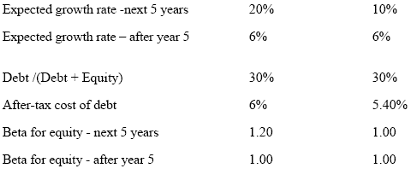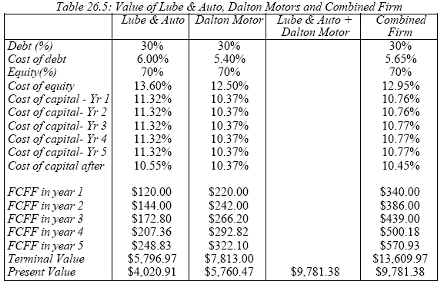A takeover motivated only by diversification considerations has no effect on the combined value of the two firms involved in the takeover, when the two firms are both publicly traded and when the investors in the firms can diversify on their own. Consider the following example. Dalton Motors, which is in an automobile parts manufacturing firm in a cyclical business, plans to acquire Lube & Auto, which is an automobile service firm whose business is non-cyclical and high growth, solely for the diversification benefit. The characteristics of the two firms are as follows:


The treasury bond rate is 7%, and the market premium is 5.5%. The calculations for the weighted average cost of capital and the value of the firms are shown in Table 26.5:

The cost of equity and debt for the combined firm is obtained by taking the weighted average of the individual firm's costs of equity (debt); the weights are based upon the relative market values of equity (debt) of the two firms. Since these relative market values change over time, the costs of equity and debt for the combined firm also change over time. The value of the combined firm is exactly the same as the sum of the values of the independent firms, indicating that there is no value gain from diversification.
This equality does not imply, however, that the shareholders in the bidding and target firms are indifferent about such takeovers, since the bidding firm pays a significant premium over the market price. To the extent that these firms were correctly valued before the merger (Market Value of Lube & Auto = $4,020.91, Market Value of Dalton Motors = $5,760.47), the payment of a premium over the market price will transfer wealth from the bidding firm to the target firm. The absence of added value from this merger may seem puzzling, given the fact that the two firms are in unrelated businesses and thus should gain some diversification benefit.
In fact, if the earnings of the two firms are not highly correlated, the variance in earnings of the combined firm should be significantly lower than the variance in earnings of the individual firms operating independently. This reduction in earnings variance does not affect value, however, because it is firm-specific risk, which is assumed to have no effect on expected returns. (The betas, which are measures of market risk, are always value-weighted averages of the betas of the two merging firms.) But what about the impact of reduced variance on debt capacity? Firms with lower variability in earnings can increase debt capacity and thus value. This can be a real benefit of conglomerate mergers, and we consider it separately later in this section.
Cash Slack
Managers may reject profitable investment opportunities if they have to raise new capital to finance them. Myers and Majluf (1984) suggest that since managers have more information than investors about prospective projects, new stock may have to be issued at less than true value to finance these projects, leading to the rejection of good projects and to capital rationing for some firms. It may therefore make sense for a company with excess cash and no investment opportunities to take over a cash-poor firm with good investment opportunities, or vice versa. The additional value of combining these two firms is the present value of the projects that would not have been taken if they had stayed apart, but can now be taken because of the availability of cash.
Cash slack can be a potent rationale for publicly traded firms that have more access to capital and want to acquire small, private firms that have capital constraints. It may also explain why acquisition strategies concentrating on buying smaller, private firms have worked fairly well in practice. Blockbuster video (video rental) , Browning and Ferris (waste disposal) and Service Merchandise (funeral homes) are good examples.
Tax Benefits
Several possible tax benefits accrue from takeovers. If one of the firms has tax deductions that it cannot use because it is losing money, whereas the other firm has income on which it pays significant taxes, combining the two firms can result in tax benefits that can be shared by the two firms. The value of this synergy is the present value of the tax savings that result from this merger. In addition, the assets of the firm being taken over can be written up to reflect new market values in some forms of mergers, leading to higher tax savings from depreciation in future years.
In Practice 26.5: Tax Benefits of writing up Asset Values after Takeover: Congoleum Inc.
One of the earliest leveraged buyouts (LBOs) occurred in 1979 and involved Congoleum Inc., a diversified firm in ship building, flooring, and automotive accessories. Congoleum’s own management bought out the firm. The favorable treatment that would be accorded the firm’s assets by tax authorities was a major reason behind the takeover. After the takeover –– estimated to cost approximately $400 million –– the firm was allowed to write up its assets to reflect their new market values and to claim depreciation on these new values. The estimated change in depreciation and the present value effect of this depreciation, discounted at the firm's cost of capital of 14.5%, are shown in Table 26.6.


Note that the increase in depreciation occurs in the first seven years, primarily as a consequence of higher asset values and accelerated depreciation. After year seven, however, the old and new depreciation schedules converge. The present value of the additional tax benefits from the higher depreciation, based upon a tax rate of 48%, amounted to $41.76 million, about 10% of the overall price paid on the transaction. In recent years, the tax code covering asset revaluations has been significantly tightened. While acquiring firms can still reassess the value of the acquired firm’s assets, they can do so only up to fair value.
Prof. Aswath Damodaran
Next: Debt Capacity
Summary: Index